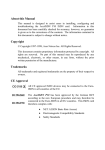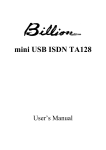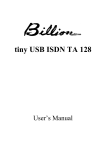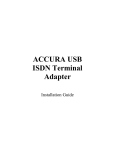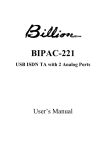Download Billion PCI User`s manual
Transcript
BIPAC-PCI ISDN Card User’s Manual CE Approval All CE approved ISDN devices may be connected to the EuroISDN in all countries of the EU. The BIPAC-PCI ISDN card has been approved by the TÜV according to the new European procedure and may therefore be connected to the Euro-ISDN in all EU countries. This ISDN card therefore complies with: ♦ CTR-3 (ISDN Basic Rate Access) ♦ Electromagnetic Compatibility Standards ♦ Safety Standards CE/EMC Restriction of Liability The product described in this handbook was designed, produced and approved according to the EMC-regulations and is certified to be within EMC limitations. If the product is used in an uncertified PC, the manufacturer undertakes no warranty in respect to the EMC limits. The described product in this handbook was constructed, produced and certified so that the measured values are within EMC limitations. In practice and under special circumstances, it may be possible, that the product may be outside of the given limits if it is used in a PC that is not produced under EMC certification. It is also possible in certain cases and under special circumstances, which the given EMC peak values will become out of tolerance. In these cases, the user himself is responsible for compliance with the EMC limits. The manufacturer refuses all liability claims and may not be liable in any cases, which may occur in the practical use of the product outside of the EMC limitation. Contents CHAPTER 1 INTRODUCTION 1.1 An Overview of the BIPAC-PCI ISDN Card 1.1.1 What is ISDN? 1.1.2 The BIPAC-PCI ISDN Card 1.2 ISDN Phone Software (Optional) 1.3 Package Contents 1.4 BIPAC-PCI ISDN Card Features 1 1 1 1 2 2 4 5 CHAPTER 2 6 INSTALLATION 6 2.1 Before Installing 2.2 Installing the BIPAC-PCI ISDN Card 2.3 Installing the BIPAC-PCI ISDN Card Drivers 2.4 ISDN Utility Installation 2.4.1 The Diagnostic Program 2.4.2 The ISDN Status Program 2.5 Using Multilink PPP 2.6 Uninstalling the BIPAC-PCI ISDN Card CHAPTER 3 TROUBLESHOOTING 6 6 8 21 23 24 25 28 29 29 Chapter 1 Introduction 1.1 An Overview of the BIPAC-PCI ISDN Card 1.1.1 What is ISDN? ISDN is an abbreviation for Integrated Services Digital Network. ISDN transfers information digitally and integrates all telecommunication services (such as telephone, teletext, videotex, etc.) into a single network. Using ISDN, you can transfer text, voice, data files, images, and even video. Before the use of ISDN, telecommunications operated using analog devices, which limited the quality of telecommunication transfers. With ISDN technology, the telephone lines can transmit data digitally with much greater speed and clarity of transmission than with analog transmissions. The ISDN is capable of transmitting all kinds of information at greatly accelerated rates. A typical modem transmission has a rate of 56Kbps (kilobits per second or thousand bits per second). ISDN digital technology allows transfer rates of up to 128Kbps. Because ISDN transmits data digitally, the data is virtually error free, and the transmission is much clearer, with fewer interruptions and slowdowns in facsimile transmissions. With ISDN devices implemented throughout the world, a truly digital 1 Billion BIPAC-PCI ISDN card network will emerge, allowing everyone fast and easy access to the global information highway. 1.1.2 The BIPAC-PCI ISDN Card The BIPAC-PCI ISDN card is ideally suited to give your PC access to the world of the Integrated Services Digital Network. It is easy to install, and easy to configure because it is fully Plug and Play compatible. The Windows 95, OSR2, 98, NT4.0, Me, 2000 or XP operating system will automatically install and configure the ISDN card. With the ISDN card, you can have an ISDN telephone, answering machine, file transfer, videotex, G3/G4 Fax functions, and Internet access. This will bring you more versatility and efficiency in the ISDN era. 1.2 ISDN Phone Software (Optional) The ISDN card transmits voice signals with a much greater quality, clarity, and speed than analog voice transmissions. Included in some product package is the ISDN Phone software program, which takes full advantage of the ISDN card’s digital 2 Chapter 1 Introduction transmission capabilities. This program makes it easy for you to make and receive voice communications. With the Phone program and some ISDN card, you will be able to use the two B channels simultaneously, allowing you to send voice and data over the ISDN card at the same time. You can use your ISDN card to make a voice communication over one B channel while sending data or connecting to the Internet using the other B channel. The ISDN Phone has the following additional features: A Software Dialer The Software Dialer allows you to dial the telephone number using either the mouse or your keypad. Hot Key Dialing The Hot Key feature allows you use a hot key combination to automatically dial a number that has been copied to the clipboard. If you have a database with phone numbers stored in it, you can use the Windows shortcut keys [Ctrl] + [C] to copy the number, and then use the assigned ISDN Phone hot key to dial the number for you. Speed Dialing The Speed Dialing function allows you to dial a number with a single mouse click. You can store up to 16 numbers with the Speed Dialing function. Automatic Redial Automatic Redial frees you from having to manually redial if the line is busy. You can set the Automatic Redial function to redial after a designated period of time. Phone Book The Phone Book allows you to store phone numbers and other important information about your contacts. You can even insert a 3 Billion BIPAC-PCI ISDN card photograph image identification. to help you with Call Logs Call Logs help you keep track of incoming and outgoing communication data such as caller identification, duration of the call, and the date and time the call was made. Supplementary Services “Call hold/retrieve”, “suspend/resume”, “call waiting”, “call transfer”, “call forwarding”, etc. For more information about the ISDN Phone program, please consult the ISDN Phone User’s Manual. 1.3 Package Contents The product package comes with the following accessories: 4 1. One Billion BIPAC-PCI ISDN card 2. One installation CD with drivers and utility software 3. One CD with bundled application software programs (optional) 4. One RJ-45 ISDN cable 5. One Quick Start Guide 6. One headset with RJ-11 connector (optional) Chapter 1 Introduction 1.4 BIPAC-PCI ISDN Card Features The BIPAC-PCI ISDN card supports many standard and enhanced features, including the following: ♦ Fully Plug and Play compatible. ♦ Provides telephony functions with a headset (optional). ♦ Supports both 16-bit and 32-bit CAPI drivers for Windows 95/OSR2/98/NT/ Me/2000 and XP. ♦ Supports TAPI and NDIS WAN miniport drivers for Windows 95/OSR2/98/NT/Me/2000 and XP. ♦ Supports Multilink PPP (MP) for 128Kbps (two B channels) internet access and data transfer. ♦ Supports X.75, T.70NL, ISO8208, T.90, and HDLC transparent protocols on the B channel for T-Online, AOL, CompuServe, BTX, BBS, Eurofile transfer, and G4 Fax. ♦ Has support for a bit-transparent driver on the B channel for answering machine and G3 Fax functions. ♦ Supports both V.110 and V.120 rate adaptation. ♦ Supports COM port application programs. simulation for modem-based If you want to send and receive the Group 3 (G3) fax at 14.4Kbps, you should have a Pentium processor. 5 Chapter 2 Installation 2.1 Before Installing Make sure that you have all you need to install the ISDN card. You should have the following: 1. An IBM compatible PC with Pentium 166MHz or above with at least 32MB of RAM. 2. One free interrupt (IRQ). 3. Microsoft Windows 95/OSR2/98/NT/Me/2000 or XP. 4. At least 30MB of free disk space for the driver and software. 5. A VGA compatible monitor. 6. An IBM or Microsoft compatible mouse. 7. An ISDN basic rate S0 line released by PTT (Post, Telephone and Telegraph administration). 2.2 Installing the BIPAC-PCI ISDN Card Please refer to the following instructions and figures for installation procedures: 6 Chapter 2 Installation 1. Turn off the power to your computer and all peripherals such as your monitor or printer. 2. Remove the computer system cover unit. 3. Remove the bracket from any unused expansion slot. Set the bracket screw aside. 4. Gently insert the ISDN card into the expansion slot. Make sure that the card is securely seated in the slot. If the connection is not secure, the card will not work. 5. Secure the ISDN card with the bracket screw that you removed in step 3. 6. Connect your ISDN line to the RJ-45 jack labeled “S0 LINE” on the card as shown below. 7. Optionally connect your headset to the RJ-11 jack on the ISDN card. 8. Replace the computer system cover unit and reconnect your peripheral devices. 7 Billion BIPAC-PCI ISDN card 2.3 Installing the BIPAC-PCI ISDN Card Drivers For Windows 95, OEM Service Release 2 (OSR2) or Windows 98: 1. Start Windows. After the opening banner, Windows will tell you that your ISDN card has been detected. You will then see the following screen for Windows 95: Or you will see the following screen for OSR2: 8 Chapter 2 Installation Or you will see the following screen for Windows 98: 2. Insert the installation CD into the CD-ROM drive (D: or E: , etc.). 3. For Windows95, select “Driver from disk provided by hardware manufacturer”. For OSR2, click “Next >” to go on. For Windows 98, click “Next >”. Then, check “Specify a location:” and browse for “D:\Driver\Win98” (D: represents your CD-ROM drive). 9 Billion BIPAC-PCI ISDN card 10 4. Follow the instructions on the screen. Windows will copy the driver files to Windows sub-directories. 5. Then, Windows will start copying system files and you might see the following screen prompting for the path of the Windows source files. Please specify the location of your Windows source files and click “OK”. 6. For Windows 95 or OSR2, if the Microsoft ISDN Accelerator Pack 1.1 or Dial-Up Networking 1.3 has been installed before, Windows will detect some files with newer version. Press “Yes” to keep the newer files. 7. For Windows 95 or OSR2, if the Microsoft ISDN Accelerator Pack 1.1 or Dial-Up Networking 1.3 is not installed before, you should see the following screen. Chapter 2 Installation 8. After complete installing the ISDN card driver, you will be prompted to restart the computer. Press “Yes” to restart your computer. For Windows NT 4.0: 1. Start Windows. Insert the installation CD into the CDROM drive (D: or E: , etc.). 2. Run “D:\Driver\WinNT\Setup.bat” (D: represents your CDROM drive). Then, the following window appears. 11 Billion BIPAC-PCI ISDN card 12 3. Click “OK” to begin copying files. “Setup Program” will start. After that, the 4. If your PC has PnP BIOS, you can choose “Auto setting”. Then the IRQ and I/O Port of the ISDN card will be configured by the system. 5. After setting the properties of the ISDN card, you might see the following screen prompting for the path of the Windows NT source files to installing the Remote Access Service (RAS). 6. When the RAS is installed, you will see the following screen for configuring ISDN ports as RAS devices. Chapter 2 Installation 7. Press “OK” to select “ISDN1-NTWANMP” as one of the “RAS Capable Devices”, you should then see the following screen. 8. Click “Add...” for adding “ISDN2-NTWANMP” to the list of RAS communication ports. The “ISDN1” and “ISDN2” ports make the ISDN card be capable of dialing or receiving multilink calls. For more details about configuring the multilink support in Windows NT 4.0, please refer to the on-line help of RAS. 9. Click “Continue” to complete RAS setup, and you should see the Billion BIPAC-PCI ISDN card has been installed as a network adapter. 13 Billion BIPAC-PCI ISDN card 10. Click “Close”. Then, you will be prompted to restart the computer. 11. Press “Yes” to restart your computer and finish the driver installation. For Windows Me: 1. Start Windows. After the opening banner, Windows will tell you that your ISDN card has been detected. 14 Chapter 2 Installation 2. Insert the installation CD into the CD-ROM drive (D:, or E:, etc.). Select “Specify a location:” and browse for “D:\Driver\WinME” (D: represents your CD-ROM drive). Click “Next >”. 3. After pressing “Next >” button for the next screen, then press “Finish”. 15 Billion BIPAC-PCI ISDN card 4. If the next screen appears when Windows finishes installing the drivers, press “Yes” to restart the computer. For Windows 2000: 1. 16 Start Windows. After the opening banner, Windows will tell you that your ISDN card has been detected. Press “Next>”. Chapter 2 Installation 2. Insert the installation CD into the CD-ROM drive (D:, or E:, etc.). Select “Specify a location” and browse for “D:\Driver\Win2000” (D: represents your CD-ROM drive). Click “OK”. 3. After pressing “Next >” for the next screen, click “Yes” if windows titled “Digital Signature Not Found” appear. Then, press “Finish” to end the installation. 17 Billion BIPAC-PCI ISDN card For Windows XP: 18 1. Start Windows. After the opening banner, Windows will tell you that your ISDN card has been detected. Press “Next>” 2. Click “Continue Anyway” to continue the installation. Chapter 2 Installation 3. Press “Finish”. 19 Billion BIPAC-PCI ISDN card For Linux: 1. The Linux support for the ISDN PCI card comes with the Isdn4Linux package. First, you have to reconfigure the kernel to make the HiSax module be compiled with “Support for HFC PCI-BUS cards”. 2. You can patch your kernel with the latest ISDN kernel tree using the current CVS sources. Please refer to http://www.linuxdoc.org/HOWTO/Kernel-HOWTO.html if you are not familiar with configuring and compiling the Linux kernel. 3. If you compiled the HiSax driver as kernel module, you have to load it with the following commands: /sbin/insmod/lib/modules/2.2.10/misc/isdn.o /sbin/insmod/lib/modules/2.2.10/misc/hisax.o id=HiSax type=35 protocol=2 20 Chapter 2 Installation 4. If the kernel loads the HiSax driver, output in the message file will show up. Then, the hardware is installed. 2.4 ISDN Utility Installation The ISDN Utility includes helpful programs for the BIPAC-PCI ISDN card, such as diagnostic program, uninstallation program, on-line manual and configuration program. After Windows installs the driver of your ISDN card, the ISDN Utility may be installed automatically. If the ISDN Utility is not installed, you may install it from the installation CD. To install the ISDN Utility under Windows 95, NT4.0, 98, Me, 2000 or XP, please follow the instructions listed below. 1. Insert the installation CD into CD-ROM drive. 2. Run Windows Explorer. Enter the directory of your CDROM drive. Double-click “SETUP.exe” to install the utility. 21 Billion BIPAC-PCI ISDN card 22 3. When the following window prompts, click on the “ISDN Utility” button. 4. The Install Shield Wizard will load the ISDN Utility Installation program. 5. Press “Next>” to begin installing the ISDN Utility. Follow the instructions on the screen to complete the installation. Chapter 2 Installation 2.4.1 The Diagnostic Program After you have installed your BIPAC-PCI ISDN card, you are highly recommended to use the diagnostic program to make sure the ISDN card, its drivers and the ISDN line are all properly installed and connected. To run the diagnostic program, please follow these instructions: 1. Open the “Programs” folder on the “Start” menu and click on the “ISDN Utility” item. 2. Click on the “Diagnostic Program” item, you will see the following screen. 3. The IRQ and I/O Port hardware configuration is listed. 4. In the “Own ISDN Number” box, type in the subscriber number of your own ISDN line. 5. Press “Loopback Test” to begin the diagnostic procedure. It will make a call from the B1 channel that returns through the B2 channel. The D and B channels will be tested for line integrity. 23 Billion BIPAC-PCI ISDN card 6. Please refer to Chapter 3 Troubleshooting if you see any error or warning message. 2.4.2 The ISDN Status Program To know the status of ISDN line and B channels, you can start the ISDN Status program as below: 1. 2. 3. 24 Open the “Programs” folder on the “Start” menu and click on the “ISDN Utility” program folder. Click on the “ISDN Status” item to start the program. You will see the status of ISDN S0, B1 channel and B2 channel. Chapter 2 Installation 2.5 Using Multilink PPP To use multilink, the answering Internet Service Provider (ISP), online service or corporate LAN must provide multilink capabilities. To configure multilink support, follow these steps. 1. Double click on the “My Computer” icon on your Windows Desktop, and then double click on the “Dial-Up Networking” (DUN) folder. 2. The DUN folder displays an icon labeled “Make New Connection”, plus icons for each of the connections that you have already created. If you have not yet created a connection, double click on “Make New Connection” to define a connection to the dial up service you wish to use. 3. When you have created your connection, or if the connection you wish to use for multilink access already exists in the folder, use the mouse to right click on the connection icon. Choose the “Properties” option. This displays a dialog box with several category tabs at the top. 25 Billion BIPAC-PCI ISDN card 26 4. Select the “Multilink” tab,and then select the “Use additional devices” radio button. 5. Click “Add…” to specify the device to be bundled together to form the multilink connection. Chapter 2 Installation 6. Use the “Add…”, “Remove”, and “Edit” buttons to change the list of additional devices. 7. You may enter a different phone number for each device; the phone numbers will be stored. If you subsequently change the phone number for the connection icon, the phone numbers associated with additional devices on this page will not change. After all devices are configured, you are ready to dial the multilink connection. Once the connection is established, you can view the status information by double clicking on the “Communicating Computers” icon displayed in the taskbar. The following window opens: Communicating Computers icon The status information includes the number of bytes sent and received, the network protocols negotiated for use on the connection and a list box showing each of the additional devices. As you highlight a device in the list box, a “Suspend” or “Resume” button is displayed. 27 Billion BIPAC-PCI ISDN card If a “Suspend” button is displayed, the additional device is now in use and bundled into the multilink connection. Clicking on the “Suspend” button disconnects that device and removes the additional device from the bundled connections. If the “Resume” button is displayed, then click on “Resume” to dial that connection and add that additional device to the bundle. You may suspend and resume individual additional device without dropping the connection. 2.6 Uninstalling the BIPAC-PCI ISDN Card If you decide to permanently remove the driver and utility of the ISDN card from your system, you must run the uninstallation program from the ISDN Utility program group as follows: 28 1. Open the “Programs” folder on the “Start” menu and click the “ISDN Utility” item. 2. Click the “Uninstall DRV & UTL” item. The following ISDN Uninstallation Program window appears. 3. Check the item(s) that you want to completely remove from the Windows system and press “OK”. Chapter 3 Troubleshooting If the BIPAC-PCI ISDN card is not functioning properly, you can refer first to this chapter for simple troubleshooting before contacting your service provider. This could save you time and effort. However, if the symptoms persist, then consult your service provider. Note that some problems may be due to your telephone line. If this is the case, contact your telephone company for assistance. Here are some basic faults that are often overlooked by users. Follow these procedures for troubleshooting the ISDN card. Error Indication Possible Cause Remedy You are not allowed to run this program. The CAPI2032.DLL is not from the ISDN package. Uninstall and then reinstall the ISDN device. A required .DLL file, CAPI2032.DLL, was not found. The CAPI2032.DLL is missing. Uninstall and then reinstall the ISDN device. CAPI driver is not loaded. The Registration key has been destroyed. Uninstall and then reinstall the ISDN device. Please input your own number. The subscriber number of your own ISDN line has not been entered. Key in the subscriber number of your ISDN line in the Own ISDN Number box. 29 Billion BIPAC-PCI ISDN card Error Indication Possible Cause Cannot activate S0 interface. The ISDN line is not connected. Ensure that the ISDN S0 line is securely connected to the RJ45 jack. Cannot establish LAPD link. The ISDN line may be malfunctioning. Ensure that the ISDN S0 line is in good condition. Connecting fail. 1. Own ISDN Number is incorrect. 1. Ensure that your ISDN number is correct. 2. Other devices on the same S0 line are occupying the B channel. 2. Be sure no other device is on the same S0 line and occupying the B channel. 3. The ISDN protocol is wrong. 3. Check to see if the ISDN protocol configuration is correct. (error code = xxxx) Data transfer error. 30 The ISDN line is not in good condition. Remedy Check the ISDN line.



































